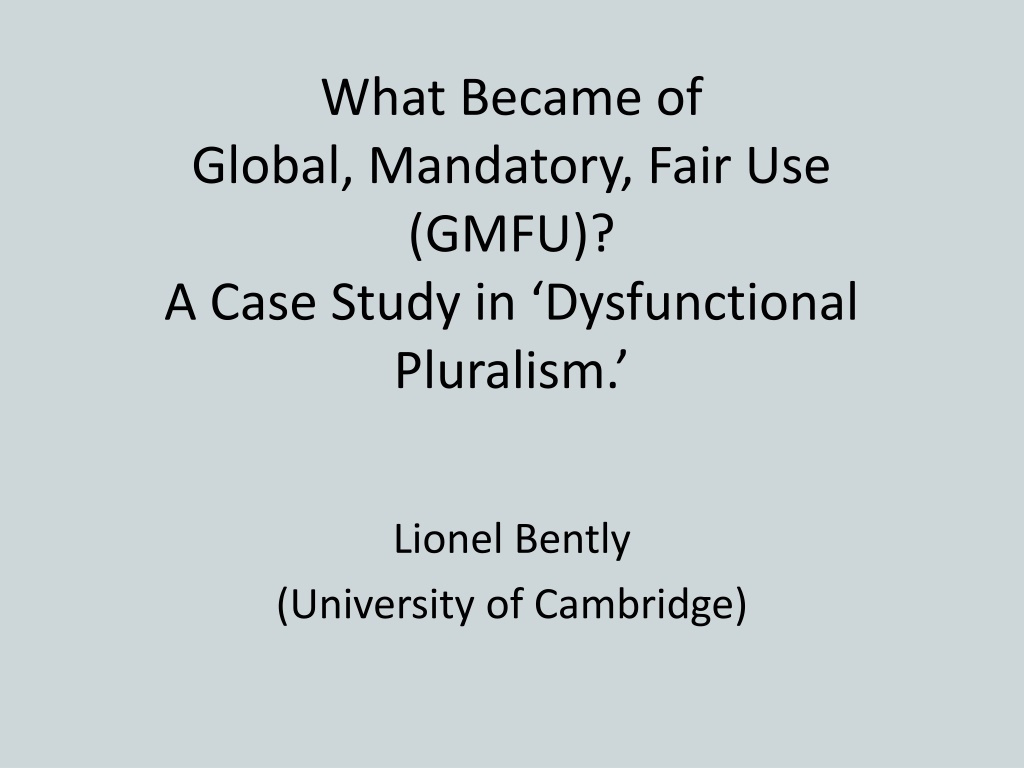
GMFU and Dysfunctional Pluralism: A Case Study
Explore the concept of Global Mandatory Fair Use (GMFU) and its evolution into a dysfunctional pluralism framework, as presented by Lionel Bently from the University of Cambridge. The study delves into the challenges and varying interpretations of fair use across different jurisdictions, shedding light on the complexities of international copyright law.
Download Presentation

Please find below an Image/Link to download the presentation.
The content on the website is provided AS IS for your information and personal use only. It may not be sold, licensed, or shared on other websites without obtaining consent from the author. If you encounter any issues during the download, it is possible that the publisher has removed the file from their server.
You are allowed to download the files provided on this website for personal or commercial use, subject to the condition that they are used lawfully. All files are the property of their respective owners.
The content on the website is provided AS IS for your information and personal use only. It may not be sold, licensed, or shared on other websites without obtaining consent from the author.
E N D
Presentation Transcript
What Became of Global, Mandatory, Fair Use (GMFU)? A Case Study in Dysfunctional Pluralism. Lionel Bently (University of Cambridge)
What is GMFU? Berne Convention, Art 10(1) Article 10 Certain Free Uses of Works: (1) It shall be permissible to make quotations from a work which has already been lawfully made available to the public, provided that their making is compatible with fair practice, and their extent does not exceed that justified by the purpose, including quotations from newspaper articles and periodicals in the form of press summaries.
Why Art 10 is GMFU (i) Global (181 MS) (ii) Mandatory It shall be permissible (iii) Fair Proportionality/Fair Practice Made Available/Attribution (iv) Use: Meaning of Quotation Not Limited by Purpose Ordinary use broad.
2. What Became of GMFU? Glocalisation/ Dysfunctional Pluralism ? Members added conditions eg (i) purpose ( criticism or review - UK) (ii) short (France) (iii) without modification (Painer, [AG]) (iv) incorporation into another work (Spain) (v) comment/referencing back (Painer, [AG]) (vi) remuneration (Spain)
3. Discursive and Institutional Facilitation of Dysfunctional Pluralism 1. Presented as optional not mandatory: eg EU ISD 2. Assumed subject to 3-step test 3. Dominance of textual/print conception 4. Absence of Enforcement mechanism and/or nation state with interest to enforce
How? (1) Optional Cf. Art 5(3)(d) of Info Soc Directive (MS may provide ) Ficsor/von Lewinski: does not fit well with nature of Berne (minimum standards, connecting factors) For Berne works. Cf. neighbouring rights
Better View: Mandatory Language: it shall be permissible Commentators: Ricketson & Ginsburg; Hugenholtz & Goldstein; Grosse Ruse-Khan & Kur; Xalabarder; Senftleben Travaux: the UK proposed at the meeting of Government experts to make option, and the proposal was rejected (1965)
How? (2) The Obsession with the Three Step Test TRIPs, Art 13 Members shall confine limitations or exceptions to exclusive rights to certain special cases which do not conflict with a normal exploitation of the work and do not unreasonably prejudice the legitimate interests of the right holder BUT TRIPs, Article 9(1) Members shall comply with Articles 1 through 21 of the Berne Convention (1971) and the Appendix thereto. TRIPs, Art 2(2) Nothing in Parts I to IV of this Agreement shall derogate from existing obligations that Members may have to each other under the Paris Convention, the Berne Convention, the Rome Convention and the Treaty on Intellectual Property in Respect of Integrated Circuits.
How? (3) The Dominance of Textual/Print Thinking Import assumptions from typical quotation in literary sphere But ordinary meaning in context Berne applicable to music, art and film too Here ordinary use of term quotation covers: use of whole; transformative uses; uses without explicit critical commentary.
Commentaries Michael Fried calls D jeuner perhaps the most notorious instance of quotation from the Old Masters in Manet s oeuvre. (150) Fried explains the three foregrounded figures in Manet s painting are a direct quotation from Marcantonio Raimondi s engraving. Beatrice Farwell, answering her question Why did he [Manet] need Raphael explains that in doing so Manet was invoking the ideal, and that it is this and not weakness of imagination that lay behind Manet s quotations of the old masters. Likewise, CUNY Professor of Art History, Carol Armstrong, calls it perhaps the most concentrated exercise in eclectic quotation since The Old Musician of 1860.
How? (4) Institutional Context No enforcement mechanism until WTO. Who would bring action to complain about national law?
4. Conclusion: Restoring GMFU 1. Time is right to reverse dysfunctional pluralism. 2. Need for more breathing space. 3. Towards a global conception of fairness 4. GMFU not as broad as US fair use
